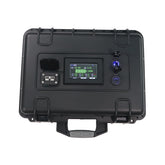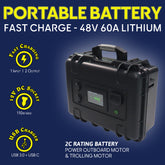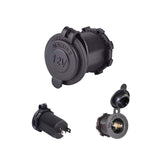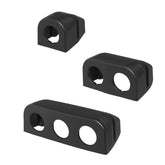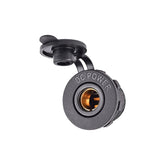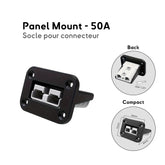
Power sockets and USB Charger
Power Sockets and USB Chargers for Boats - Reliable and Fast Charging Solutions
In today’s boating world, having access to reliable power sockets and fast-charging USB chargers is essential. Whether you need to power navigation systems, charge mobile devices, or install additional electronic components, choosing high-quality electrical accessories ensures safety, efficiency, and convenience.
Baywatt provides premium power sockets and fast USB chargers specifically designed for boats. Our products feature ECE R10 certification for electromagnetic compatibility, ensuring they do not interfere with radios, radars, Wi-Fi, or other onboard sensors. Engineered with marine-grade materials, they are waterproof, dustproof, and built to withstand the harshest environments while delivering fast, efficient power.
Why Choose Baywatt Power Sockets and USB Chargers
- Baywatt’s power sockets and USB chargers offer unmatched reliability, safety, and compatibility. Here’s why they stand out:
- Fast-charging technology optimized for new-generation smartphones, tablets, and navigation devices.
- ECE R10 certification ensures electromagnetic compatibility, preventing interference with radios, radars, Wi-Fi, and other sensors.
- Marine-grade, corrosion-resistant materials ensure durability in harsh boating conditions.
- Easy installation with modular panel brackets for seamless integration into boat dashboards and control panels.
- Flexible power solutions, including 12V and 24V compatibility for various applications.
Baywatt Power Sockets and USB Chargers
Panel Brackets - Easy Installation and Flexible Applications
Baywatt panel brackets provide a stable and secure mounting solution for USB chargers, power sockets, and voltmeters. They allow for easy and organized installation on dashboards, control panels, and remote locations. Designed for durability, these brackets ensure vibration resistance and long-lasting performance in boats and off-grid setups.
Power Sockets - Secure and Reliable Power Connections
Universal Power Plug 12V 20A
A robust and compact 12V 20A power plug with a twist-and-lock mechanism that prevents accidental disconnections. Perfect for boat decks and areas where secure power connections are necessary. This version is marine-grade.
12V Socket Universal Boat Grade
Designed for boat use, this 12V socket features a waterproof cap to protect against moisture, dust, and corrosion. Compatible with all standard 12V plugs, making it versatile for various applications.
DIN Plug 12V 20A - Screw Terminal
This 12V 20A DIN plug features screw terminals for secure and simple wiring. Its compact design allows for installation in tight spaces, making it ideal for boats and off-grid power setups.
Boat Grade 12V 20A Power Socket
A premium 12V 20A power socket with a self-locking mechanism to prevent disconnections caused by vibrations. Features a waterproof cap for maximum protection in harsh marine environments.
USB Chargers - Fast Charging and High Efficiency
Marine Dual USB 3.0 and USB-C Fast Charger Socket (12V/24V)
This fast charger combines USB 3.0 and USB-C ports, providing efficient charging for multiple devices. Designed for 12V and 24V systems, it withstands harsh boat conditions while ensuring reliable, high-speed charging.
Marine Dual USB-C Fast Charger Socket (12V/24V)
A premium dual USB-C charger designed for modern devices. Waterproof, dustproof, and impact-resistant, this charger ensures rapid charging in all conditions without compromising safety.
Marine Dual USB 3.0 Fast Charger Socket (12V/24V)
Equipped with dual USB 3.0 ports, this charger delivers high-speed charging for smartphones, tablets, and other USB-powered devices. Its flush-mounted design provides a sleek, space-saving installation.
Key Benefits of High-Quality Power Sockets and USB Chargers
Choosing the right power sockets and USB chargers enhances safety, convenience, and longevity.
Fast and Efficient Charging
Baywatt’s fast-charging USB sockets deliver optimized power output, ensuring quick and efficient charging for mobile devices, navigation equipment, and onboard electronics.
Enhanced Safety with ECE R10 Certification
ECE R10 certification guarantees electromagnetic compatibility, meaning Baywatt’s power sockets and USB chargers will not interfere with onboard radios, radars, or Wi-Fi systems.
Durability and Longevity
Constructed with high-grade corrosion-resistant materials, Baywatt products are designed to withstand water, salt, and rough conditions for long-lasting performance.
Flexible Installation Options
Flush-mounted, wall-mounted, and modular panel brackets allow seamless integration into different boat applications, providing both functionality and aesthetic appeal.
Why Choose Baywatt for Your Power Sockets and USB Chargers
Baywatt offers premium-quality power sockets and USB chargers that combine fast charging, durability, and ease of installation. With ECE R10 certification, our products ensure seamless operation without electromagnetic interference, making them the best choice for boat owners in 2025.
Explore our full range of power sockets and USB chargers at www.baywatt.com
-
Marine Dual USB 3.0 Fast Charger Socket (12V/24V)⚓ Marine Grade Power Socket - Dual Usb 3.0 ⚡ High-Efficiency Charging Capable of simultaneously charging two devices, our socket delivers high efficiency for all your power needs. With port 1 and port 2 providing both a solid output of 18W, you can swiftly...
- 12.45€
- 12.45€
- Unit price
- per
-
Marine Dual USB 3.0 & USB-C Fast Charger Socket (12V/24V)⚓ Marine Grade Power Socket - Dual USB 3.0 & USB-C ⚡ High-Efficiency Charging Capable of simultaneously charging two devices, our socket delivers high efficiency for all your power needs. With port 1 of 18W and port 2 of 60W Fast charge, you can...
- 20.55€
- 20.55€
- Unit price
- per
-
Marine Dual USB-C Fast Charger Socket (12V/24V)⚓ Marine Grade Power Socket - Dual USB Type C ⚡ High-Efficiency Charging - 60W Capable of simultaneously charging two devices, our socket delivers high efficiency for all your power needs. With Port 1 and Port 2 at 60W Max, you get the fast...
- 21.55€
- 21.55€
- Unit price
- per
-
Single Round Bracket for 12V Accessories⚡ Round Bracket for Power & Monitoring (12V/24V) This single round bracket offer different solution compare to other panels. It is particularly useful in small area that require to mount the accessory upside down or side-way. 📣 Features: Compatible with usb chargers /...
- 2.30€
- 2.30€
- Unit price
- per
-
12V Plug Universal - Marine Grade⚡ Powerhouse Performance: Marine Grade Standard Cigar plug 12V 10A (120W) with proof sealing ring. AGC Fuses repleacable and Led Indicator. Glass fiber reinforced Nylon Body - Flame retardant. 🔒Twist & Lock feature: it has a self locking point with the compatible socket : Ref PP12V...
- 5.70€
- 5.70€
- Unit price
- per
-
12V Socket Universal- Marine Grade⚡ Powerhouse Performance: Marine Grade Universal Cigar Socket 12V DC. 12V 20A. With 6.3mm terminals and waterpoof cap. 🔒Locking feature: The socket has a self locking point with the compatible plug : Ref PS12V Once plug in, the connector won't go off accidentally with vibrations or if...
- 5.00€
- 5.00€
- Unit price
- per
-
Modular Power & Monitoring Panels (Flush Mount)⚡ Customizable Power & Monitoring Panels (12V/24V) Our modular power socket systems offer versatile solutions for creating tailored electrical panels for boats, You can decide either if you prefer surface mount or flush mount for your project. we offer both options. 🔧 Panel Mount:...
- From 1.80€
- From 1.80€
- Unit price
- per
-
Modular Power & Monitoring Panels (Surface Mount)⚡ Customizable Power & Monitoring Panels (12V/24V) Our modular power socket systems offer versatile solutions for creating tailored electrical panels for boats, You can decide either if you prefer surface mount or flush mount for your project. we offer both options. 🔧 Panel Mount:...
- From 2.60€
- From 2.60€
- Unit price
- per
-
Din Plug 12V 20A - ISO 4165 Bipolar⚡ Powerhouse Performance: Compact and steady plug, ideal for marine application. 12v 20A. ISO 4165 🔒Twist & Lock feature: it has a self locking point with the compatible socket : Ref PS12V Once plug in, the connector won't go off accidentally with vibrations or if...
- 3.50€
- 3.50€
- Unit price
- per
-
Waterproof DIN Socket 12V 20A - ISO 4165 Bipolar⚡ Powerhouse Performance: Marine Grade Bipolar DIN Socket 12V DC Power Socket 12V 20A. ISO 4165 With 6.3mm terminals and waterpoof cap. 🔒Locking feature: The socket has a self locking point with the compatible plug : Ref PS12VS Once plug in, the connector won't go off...
- 4.10€
- 4.10€
- Unit price
- per
-
Plug Panel for power connectors (50A)Pack of 2pcs : Plug Panel for power connectors (50A) Efficiently organize your power connection. Whether you're setting up a battery system on a boat, powering solar or link any electric devices. The Plug Panel provides a convenient solution for managing multiple connections in...
- 11.20€
- 11.20€
- Unit price
- per




